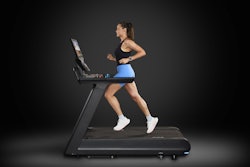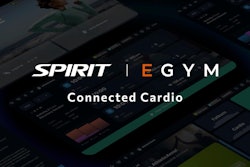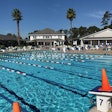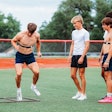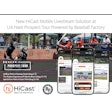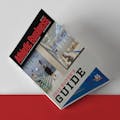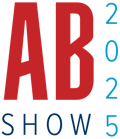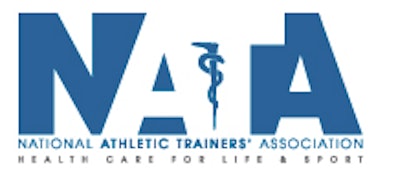
CARROLLTON, TEXAS, December 5, 2024 – The National Athletic Trainers’ Association (NATA) hosted its’ second Instagram Live AT (Athletic Trainer) Spotlight today and featured just published research in the Journal of Athletic Training, the association’s scientific publication. Predictors of Concussion Symptom-Reporting Intention Among College Athletes, appears in the November issue.
NATA President AJ Duffy III, MS, ATC, PT spoke with study lead author Daniel Baer, PhD, LAT, ATC, clinical education coordinator, Department of Sports Medicine, West Chester (PA) University. To watch the chat, please visit @NATA1950 on Instagram.
“Underreporting of concussion symptoms in college athletics presents a challenge for sports medicine clinicians with regard to evaluation and diagnosis,” says Dr. Baer. “Some athletes do not recognize they have a brain injury and many others intentionally withhold symptoms to avoid removal from sports participation. We hope our findings help clinicians develop more focused interventions that address that underreporting.”
Study Insights
- The emergence of sport-related concussion as a public health concern over the past two decades has increased awareness and understanding of the potential dangers of traumatic brain injuries in sports.1-4
- The large percentage of undiagnosed injuries makes the actual incidence of sport-related concussion difficult to identify; however, existing evidence suggests that 33% to 69% of sport-related concussions go undiagnosed.1,5-11
- Among collegiate athletes, one study found that 47.6% of male and female athletes continued to participate in their sports despite experiencing concussion symptoms after an impact;12 another noted that despite formal concussion education, 43% of previously concussed athletes had consciously hidden symptoms, and 22% of athletes indicated that they would be unlikely or very unlikely to report future concussions.13
Study Design/Method
- The cross-sectional study included 2,649 collegiate student athletes from 23 sports across 22 Pennsylvania colleges and universities.
- Participants completed an online survey.
Key Findings
- College athletes’ attitudes toward concussion symptom reporting, perceived norms (expected behavior) related to reporting, and capacity (perceived ability) to report were the strongest predictors of intention to report concussion symptoms.
- Athletes with stronger athletic identities, those with less perceived concussion knowledge, and those in collision sports (football, ice hockey, men’s lacrosse, rugby, wrestling) had lower intentions to report symptoms, but these effects were mediated by attitudes, norms, and capacity.
- Strategies to improve concussion reporting should go beyond education about symptoms and incorporate a multipronged approach to improve attitudes toward reporting, correct norm misperceptions, and empower athletes to seek appropriate care.
“This expansive study has provided important insights to help us navigate more effective and efficient reporting of collegiate athlete concussion symptoms,” said NATA President AJ Duffy III, MS, ATC, PT. “Our ultimate goal as athletic trainers is to keep student athletes safe and to prevent and/or manage injury should it occur. Having that trust and honest, open communication is critical for proper diagnosis and care. This research reinforces the importance of that communication and a roadmap ahead.”
References:1Kerr ZY, Register-Mihalik JK, Marshall SW, Evenson KR, Mihalik JP, Guskiewicz KM. Disclosure and non-disclosure of concussion and concussion symptoms in athletes: review and application of the socio-ecological framework. Brain Inj. 2014;28(8):1009–1021. doi:10.3109/02699052.2014. 904049
2Kroshus E, Daneshvar DH, Baugh CM, Nowinski CJ, Cantu RC. NCAA concussion education in ice hockey: an ineffective mandate. Br J Sports Med. 2014;48(2):135–140. doi:10.1136/bjsports-2013-092498
3Patricios JS, Schneider KJ, Dvorak J, et al. Consensus statement on concussion in sport: the 6th International Conference on Concussion in Sport—Amsterdam, October 2022. Br J Sports Med. 2023;57(11):695–711. doi:10.1136/bjsports-2023-106898
4Broglio SP, Cantu RC, Gioia GA, et al; National Athletic Trainers’ Association. National Athletic Trainers’ Association position statement: management of sport concussion. J Athl Train. 2014;49(2):245–265. doi:10.4085/1062-6050-49.1.07
5 McCrea M, Hammeke T, Olsen G, Leo P, Guskiewicz K. Unreported concussion in high school football players: implications for prevention. Clin J Sports Med. 2004;14(1):13–17. doi:10.1097/00042752 200401000-00003
6Kroshus E, Baugh CM, Daneshvar DH, Viswanath K. Understanding concussion reporting using a model based on the theory of planned behavior. J Adolesc Health. 2014;54(3):269–274. doi:10.1016/j.jadohealth. 2013.11.011
7Kroshus E, Garnett B, Hawrilenko M, Baugh CM, Calzo JP. Concussion under-reporting and pressure from coaches, teammates, fans, and parents. Soc Sci Med. 2015;134:66–75. doi:10.1016/j.socscimed.2015.04.011
8Kerr ZY, Register-Mihalik JK, Kroshus E, Baugh CM, Marshall SW. Motivations associated with nondisclosure of self-reported concussions in former collegiate athletes. Am J Sports Med. 2016;44(1):220–225. doi:10.1177/0363546515612082
9. Wallace J, Covassin T, Nogle S, Gould D, Kovan K. Knowledge of concussion and reporting behaviors in high school athletes with and without access to an athletic trainer. J Athl Train. 2017;52(3):228–235. doi:10.4085/1062-6050-52.1.07
10Rivara FP, Schiff MA, Chrisman SP, Chung SK, Ellenbogen RG, Herring SA. The effect of coach education on reporting of concussions among high school athletes after passage of a concussion law. Am J Sports Med. 2014;42(5):1197–1203. doi:10.1177/0363546514521774
11Schmidt JD, Weber ML, Suggs DW II, et al. Improving concussion reporting across National College Athletic Association divisions using a theory-based, data-driven, multimedia concussion education intervention. JNeurotrauma. 2020;37(4):593–599. doi:10.1089/neu.2019.6637
12Kroshus E, Garnett B, Hawrilenko M, Baugh CM, Calzo JP. Concussion under-reporting and pressure from coaches, teammates, fans, and parents. Soc Sci Med. 2015;134:66–75. doi:10.1016/j.socscimed.2015.04.011
13Torres DM, Galetta KM, Phillips HW, et al. Sports-related concussion: anonymous survey of a collegiate cohort. Neurol Clin Pract. 2013;3(4):279–287. doi:10.1212/CPJ.0b013e3182a1ba22
About NATA: National Athletic Trainers’ Association – Health Care for Life & SportAthletic trainers are health care professionals who specialize in the prevention, diagnosis, treatment and rehabilitation of injuries and sport-related illnesses. They prevent and treat chronic musculoskeletal injuries from sports, physical and occupational activity, and provide immediate care for acute injuries. Athletic trainers offer a continuum of care that is unparalleled in health care. The National Athletic Trainers' Association represents and supports 40,000 members of the athletic training profession. Visit nata.org for more information.

















